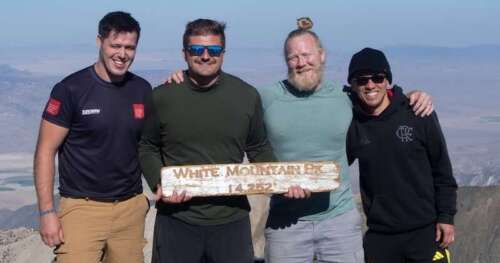It can be a fuzzy feeling of grogginess, compounded by headaches or even vomiting. It can make you dizzy, or disrupt your sleep despite constant fatigue, and sometimes it steals your appetite or leaves you short of breath.

Dr. Ben Stacey, Dr. Mike Tymko, Dr. Kurt Smith and Dr. Igor Fernandes at the summit of White Mountain.
Altitude sickness is a common ailment; however, understanding what causes it, or how to improve its treatment, are questions researchers like Dr. Mike Tymko, professor in the Department of Human Health Sciences, are still exploring.
Tymko assembled an international team of more than 30 students, researchers and clinicians who lived and worked together for 12 days, conducting more than a dozen different experiments focused on how respiratory, cardiovascular and cerebrovascular systems respond and adapt to a low-oxygen environment.
"What our team is doing is some of the most innovative work done at high altitude. The expertise within our research team is top tier," he says. "It's exciting."
U of G leads international research team in California
Assembled from Canada, the U.S. and the U.K., the multi-faceted team is pulling double duty. They will both conduct the experiments and be the test participants, working with equipment like stationary bikes, various ultrasound equipment, blood analyzers and cardiorespiratory monitoring to gauge how their bodies adapt to high altitude.
International high altitude field research is becoming increasingly difficult due to logistical constraints, Tymko explains, despite increased public access to high altitude locations around the world.
Among them is the Barcroft White Mountain Research Center based in California, which sits at an elevation of 3,800 metres, making it one of the highest research stations in North America, near the Nevada border. The team travelled there this summer for the second phase of the research that began at the University of Guelph in the spring.
Comparing the physical and mental health of the team in the two vastly different environments will provide the kind of data needed to answer questions like, "Are there ways to reduce the chances of getting sick at high altitudes?" or "Why does altitude sickness impact some and not others?"
Low oxygen environments affect sleep, blood flow
At high altitudes, most people develop central sleep apnea, Tymko explains, so the team will be fitted with wearable devices to monitor sleep patterns. His lab will focus on experiments that measure the effectiveness of supplements on altitude sickness, the effects of sleep and nerve activity and how it impacts blood flow distribution to the brain.
"Many diseases, like heart failure or chronic obstructive pulmonary disease (COPD), have a lot of the same characteristics that you experience at high altitudes with low oxygen," Tymko says. "We're essentially modelling diseases that are characterized by hypoxemia, which has a lot of clinical and real-life applicability."
Among the team are clinicians such as anesthesiologists and critical care physicians, as well as researchers and graduate students from the University of British Columbia, Duke University, University of Laval, Loma Linda University, McMaster University, Purdue University, University of South Wales, University of Victoria and the University of Windsor.
For the undergraduate and graduate students, this is a unique experience, Tymko says. Expeditions like this offer opportunities for leadership roles that develop both personal and professional independence. Tymko has been part of similar expeditions to Nepal and Peru.
Learning to live and work together in a remote environment enables students to build valuable relationships with international experts, bringing a human element that helps aid research.
"It's an experience that not many get to have," he says. "We are one of the few research groups in the world that does this kind of work."










